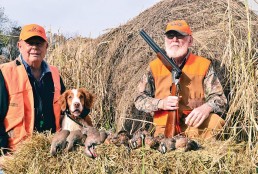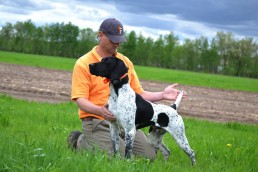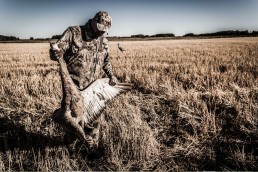Preserve Hunting More than Scratches Upland Itch
SHARE THIS POST
“Bird hunting ain’t what it used to be,” lamented Treff Earney, a hunting buddy. “But, it is great to come to a bird hunting operation and enjoy the quality habitat and strong flying birds.”
Biologists have lamented louder than Earney about the decline in upland bird hunting across the U.S. in recent decades. Habitat loss, changing agricultural practices, increased predator populations, pesticides that can kill honeybees and a decrease in hunter numbers all have contributed to the decline.
Conservation agencies know what needs to be done to bring game bird populations back to former levels. Controlling predator numbers, including feral cats, has proven to be an effective method of increasing game bird numbers. Also, encouraging new hunters to enter the sport helps maintain dollars spent toward maintaining game department funds for upland game bird conservation. However, the most important key to improving game bird numbers is providing good habitat.
“Conservation will ultimately boil down to rewarding the private landowner who conserves the public’s interest,” said Aldo Leopold, the legendary conservation leader.
The vast majority of land in the U.S. is privately owned and holds the best habitat for upland birds. Programs like the Conservation Reserve Program pays farmers to leave some of their lands in wildlife habitat. Such programs, however, are not enough to bring game birds, such as quail and pheasants, back to the national landscape. But it can take a lot of dollars and a lot of time to change agricultural practices across an entire national landscape. In the meantime, hunter numbers continue to decrease in most states and conservation department funds are decreasing proportionately.
Bill Kunz, the owner of Wil-Nor Outdoors, LLC in Dittmer, Mo., grew up as a wild bird hunter.
“I, like most quail and pheasant hunters, am passionate about the sport. For me, nothing in the outdoors comes close to matching the thrill I get from seeing a good bird dog lock down on point.”
Kunz walked behind bird dogs for hundreds of miles, but read the handwriting on the wall in the mid- 1980s.
“Game bird populations, particularly quail, were declining at an alarming rate,” he said. “Bird hunting preserves were coming on the scene. I thought preserves were the salvation of game bird hunting, but I was quickly disappointed after visiting the first few preserve operations. Bird hunting preserves were a fairly new industry and few people knew how to properly raise quality birds. The hunts I experienced proved disappointing.”
In an attempt to remedy the situation, Kunz began the Wil-Nor Acres Gun Club in 1986, and later opened Wil-Nor Outdoors in 1990. Wil-Nor offers chukar partridge, pheasant and quail hunting, along with dog boarding, training for pointing breeds, sporting clays, a rifle and pistol range, fishing ponds and concealed carry classes. Limited deer and turkey hunting are also available.
“My primary purpose in opening Wil-Nor was to provide as near a wild bird hunting experience as possible,” Kunz stated. “I purchase the best birds I can find from reputable suppliers. Good quality birds are only part of the equation, however. A good bird hunt requires quality habitat and food plots and plenty of room to hunt.”
Every upland bird hunter who remembers the good-old days of bird hunting also remembers the excellent farms they had to hunt, especially me hunting partner.
“In my younger days, I could quail-hunt on any number of farms around the area,” Earney recalled. “Everyone had brushy fence rows and draws. Many of the farms had a few row crops such as corn or soybeans and milo too.”
Are you enjoying this post?
You can be among the first to get the latest info on where to go, what to use and how to use it!
Clean row farming had not been invented yet, either. Annual weeds were plentiful on farms and provided substantial food sources for quail and songbirds.
When hill farms began declining as family operations and cattle markets expanded, row crops and brushy fencerows went by the wayside, taking with it millions of acres of prime quail habitat. The rapidly expanding usage of fescue in the 1950s as a base to prevent soil erosion on an increasing numbers of cattle farms sealed the fate of quail populations across the vast landscape. Clean row farming, fall tillage and herbicides also have created the same scenario for pheasant habitat.
Despite the fact that biologists have identified the problems associated with game bird population declines, it is unlikely populations will ever return to numbers of the glory days. Gains are being made, but if bird hunters are going to keep their sport alive and continue to attract new hunters, shooting preserves will be a part of that equation.
A search online will bring up many bird hunting operations across the country. There is no doubt that the quality of the science of raising birds for hunts has increased dramatically. High-quality operations now manage thousands of acres dedicated to quality bird hunting habitat.
“Expense is a big factor for a lot of bird hunters,” Earney said.
Working-class bird hunters can’t always afford to travel long distances and stay in costly lodges. Such hunting trips are often a once-a-year affair. And, bird hunters can’t justify keeping a dog for one hunt a year. But there are local opportunities out there.
“I love coming to Wil-Nor,” Earney said. “It is only an hour from home and costs are very reasonable.”
Earney does readily admit that bird hunting is not what it used to be.
“I miss the old farms I used to hunt,” he quipped.
The old barns, the old equipment, the farm animals, the crop fields, the farmers themselves—they all combined to create a special atmosphere which was dear to every bird hunters heart.”
Earney added that Bill Kunz is a special guy.
“He experienced the good-old days of bird hunting and does his best to give us the same experience. I couldn’t believe it, but the last time I hunted at Wil-Nor, Bill took us to an old century farm he had leased. The place was like something out of the past—huge old barns, log buildings, corn cribs, rusty Farmall tractors, Ford pickups from the ‘40s and real crop fields surrounded by brushy draws and weedy corners that took me back decades. That’s the best day I’ve had bird hunting in decades.”
Bird hunting preserves are here to stay. The grand bird hunting preserves have their places, but if you want to bird hunt often, find a well-managed preserve close to home.
MWO
SHARE THIS POST
Did you enjoy this post?
You can be among the first to get the latest info on where to go, what to use and how to use it!
Bill Cooper
An inductee to the National Fresh Water Fishing Hall of Fame, Bill Cooper, from the Missouri Ozarks, has written over 4,000 articles on outdoor subjects. You can hear him on Wild at Heart Outdoor radio at espn1073.com.




